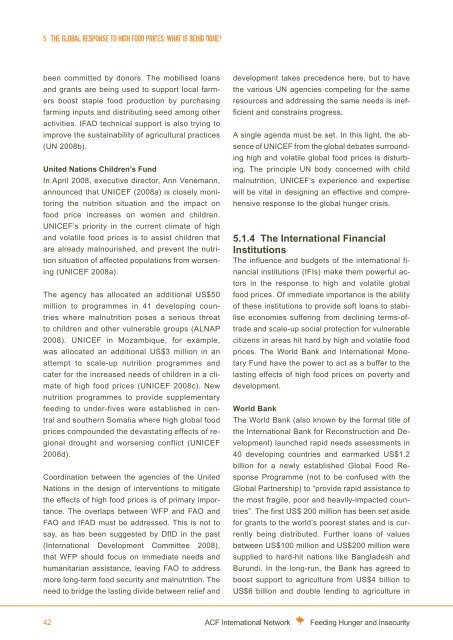Feeding hunger and insecurity
Feeding hunger and insecurity
Feeding hunger and insecurity
- No tags were found...
Create successful ePaper yourself
Turn your PDF publications into a flip-book with our unique Google optimized e-Paper software.
5. The global response to high food prices: what is being done?been committed by donors. The mobilised loans<strong>and</strong> grants are being used to support local farmersboost staple food production by purchasingfarming inputs <strong>and</strong> distributing seed among otheractivities. IFAD technical support is also trying toimprove the sustainability of agricultural practices(UN 2008b).United Nations Children’s FundIn April 2008, executive director, Ann Venemann,announced that UNICEF (2008a) is closely monitoringthe nutrition situation <strong>and</strong> the impact onfood price increases on women <strong>and</strong> children.UNICEF’s priority in the current climate of high<strong>and</strong> volatile food prices is to assist children thatare already malnourished, <strong>and</strong> prevent the nutritionsituation of affected populations from worsening(UNICEF 2008a).The agency has allocated an additional US$50million to programmes in 41 developing countrieswhere malnutrition poses a serious threatto children <strong>and</strong> other vulnerable groups (ALNAP2008). UNICEF in Mozambique, for example,was allocated an additional US$3 million in anattempt to scale-up nutrition programmes <strong>and</strong>cater for the increased needs of children in a climateof high food prices (UNICEF 2008c). Newnutrition programmes to provide supplementaryfeeding to under-fives were established in central<strong>and</strong> southern Somalia where high global foodprices compounded the devastating effects of regionaldrought <strong>and</strong> worsening conflict (UNICEF2008d).Coordination between the agencies of the UnitedNations in the design of interventions to mitigatethe effects of high food prices is of primary importance.The overlaps between WFP <strong>and</strong> FAO <strong>and</strong>FAO <strong>and</strong> IFAD must be addressed. This is not tosay, as has been suggested by DfID in the past(International Development Committee 2008),that WFP should focus on immediate needs <strong>and</strong>humanitarian assistance, leaving FAO to addressmore long-term food security <strong>and</strong> malnutrition. Theneed to bridge the lasting divide between relief <strong>and</strong>development takes precedence here, but to havethe various UN agencies competing for the sameresources <strong>and</strong> addressing the same needs is inefficient<strong>and</strong> constrains progress.A single agenda must be set. In this light, the absenceof UNICEF from the global debates surroundinghigh <strong>and</strong> volatile global food prices is disturbing.The principle UN body concerned with childmalnutrition, UNICEF’s experience <strong>and</strong> expertisewill be vital in designing an effective <strong>and</strong> comprehensiveresponse to the global <strong>hunger</strong> crisis.5.1.4 The International FinancialInstitutionsThe influence <strong>and</strong> budgets of the international financialinstitutions (IFIs) make them powerful actorsin the response to high <strong>and</strong> volatile globalfood prices. Of immediate importance is the abilityof these institutions to provide soft loans to stabiliseeconomies suffering from declining terms-oftrade<strong>and</strong> scale-up social protection for vulnerablecitizens in areas hit hard by high <strong>and</strong> volatile foodprices. The World Bank <strong>and</strong> International MonetaryFund have the power to act as a buffer to thelasting effects of high food prices on poverty <strong>and</strong>development.World BankThe World Bank (also known by the formal title ofthe International Bank for Reconstruction <strong>and</strong> Development)launched rapid needs assessments in40 developing countries <strong>and</strong> earmarked US$1.2billion for a newly established Global Food ResponseProgramme (not to be confused with theGlobal Partnership) to “provide rapid assistance tothe most fragile, poor <strong>and</strong> heavily-impacted countries”.The first US$ 200 million has been set asidefor grants to the world’s poorest states <strong>and</strong> is currentlybeing distributed. Further loans of valuesbetween US$100 million <strong>and</strong> US$200 million weresupplied to hard-hit nations like Bangladesh <strong>and</strong>Burundi. In the long-run, the Bank has agreed toboost support to agriculture from US$4 billion toUS$6 billion <strong>and</strong> double lending to agriculture in42ACF International Network<strong>Feeding</strong> Hunger <strong>and</strong> Insecurity

















